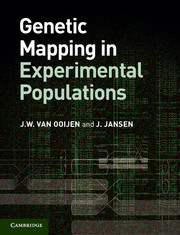Book contents
- Frontmatter
- Contents
- Preface
- 1 Introduction
- 2 Meiosis and genetic recombination
- 3 Estimation of recombination frequencies
- 4 Determination of linkage groups
- 5 Estimation of a genetic map
- 6 Criteria for the evaluation of maps
- 7 How to find the best map order
- 8 Outbreeding species
- 9 Mapping in practice
- Answers to exercises
- Index
- References
9 - Mapping in practice
Published online by Cambridge University Press: 05 August 2013
- Frontmatter
- Contents
- Preface
- 1 Introduction
- 2 Meiosis and genetic recombination
- 3 Estimation of recombination frequencies
- 4 Determination of linkage groups
- 5 Estimation of a genetic map
- 6 Criteria for the evaluation of maps
- 7 How to find the best map order
- 8 Outbreeding species
- 9 Mapping in practice
- Answers to exercises
- Index
- References
Summary
Genetic linkage mapping is a very powerful tool, but it turns out to be quite sensitive to incomplete or erroneous information. In practice, it is often impossible to record data on all loci-individual combinations. Therefore, the mapping computations have to be done with some missing observations. It also turns out that a mapping experiment is prone to errors because of the huge number of observations. In this chapter, we address some of the common problems encountered in practice.
Introduction
The preceding chapters describe the theory underlying the construction of genetic linkage maps. With suitable computer software, map construction should be straightforward. We write should, because in practice this is not always the case. There are two reasons for this. As in statistical modelling, we view map construction as a method in which observations are fitted to a model. In practice, the fit between observations and model can be far from perfect. In this case, the observations may not behave according to the model or the model is an incorrect abstraction of the way the observations behave. In our specific case of genetic map construction, this means that a poor fit may either be caused by poor quality of the marker observations or by an imperfect model of the genetics, or both.
- Type
- Chapter
- Information
- Genetic Mapping in Experimental Populations , pp. 123 - 138Publisher: Cambridge University PressPrint publication year: 2013



